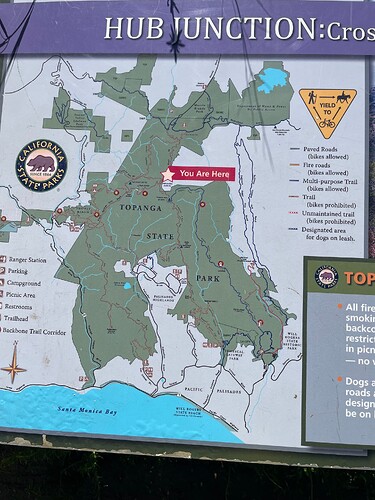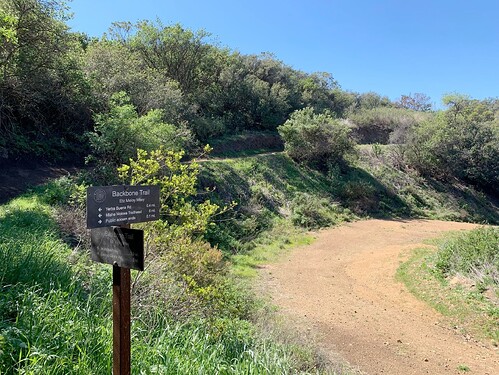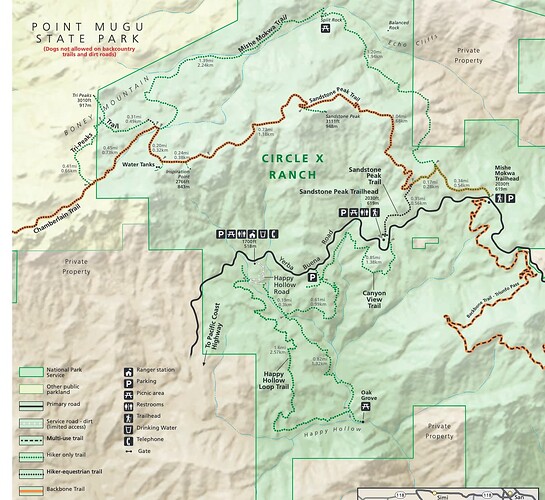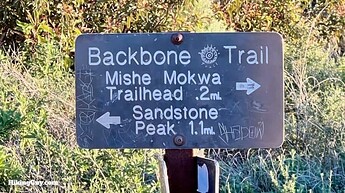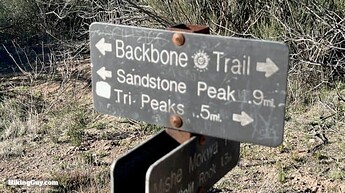This discussion has been very interesting to follow. Regarding the original post, I certainly think that short trails should preserve name= on the ways. Relations are fine if some mapper really wants to, and might even be best practice, but are not required for such short routes and definitely don’t replace names on the ways.
But to continue digressing toward the broader name vs relation issues, I’d like to put forward an example near me that’s been the subject of some slow-motion edit wars to help with this:
The Backbone Trail is a regionally, but I don’t think nationally, well-known 70 mile long trail that traverses the ridge of the Santa Monica Mountains in Southern California (network=rwn). Along its route, it uses some trails, some wider, but unpaved, fire roads, and brief stretches of paved road. The naming in OSM can be sorted into a few broad categories:
-
Some portions follow another named way which clearly has a separate name, so
namedoes not contain “Backbone Trail”. This is most obvious when the trail follows a major road for a brief portion: this way is clearly called Malibu Canyon Road despite carrying the Backbone Trail. -
Some portions are only referred to, in speaking and by signage/maps, as “the Backbone Trail”. These are simply
name=Backbone Trail, like this way. -
Some portions are part of the Backbone Trail, but also have another identity. These are more murky, and their tagging has gone back and forth. Take for example this way. It seems like it has a separate name than Backbone Trail, Temescal Ridge Trail, but just happens to carry the Backbone Trail for a portion. You can tell because the name continues to the south when the Backbone Trail branches off. This is what it looks like on a map at the Hub Junction, at the north end of the way:
On this map, the Backbone Trail is just indicated by the red and yellow blaze along named trails it follows. I think this way should havename=Temescal Ridge Trail, but you can see the OSMnamehas gone through a few different values over the last few years, and is currentlyname=Backbone Trail - Temescal Ridge Fire Road, which seems like tagging for the relation-naive renderer. -
That one seems fairly cut and dried, but there are more complicated locations. Take the Etz Meloy Motorway, currently tagged
name=Etz Meloy Motorway (Backbone Trail)(aside: sometimes fire roads, usually taggedhighway=track, are called ‘motorways’ in Southern California, which is quite the OSM oxymoron). This seems like the same deal as the Temescal Ridge Trail above, but look at the guide sign along it!
I’d still probably leanname=Etz Meloy Motorwayalone, but it’s certainly ambiguous. -
Then there’s the portion near Sandstone Peak. The NPS map indicates it’s named “Sandstone Peak Trail”, with the Backbone Trail highlighted in orange:
Compare especially to the southeastern portion on this map, which was my second example above. That part is clearly named “Backbone Trail” on the map and also carries the Backbone Trail, whereas the central section has its own name. But here are the signs on either side of “Sandstone Peak Trail”:
This looks to me a lot more like the trail is named the Backbone Trail, with Sandstone Peak as a destination. That’s why I settled on tagging itname=Backbone Trail+alt_name=Sandstone Peak Trail, with an explanatorynote.
This ended up being long winded, probably because it’s been bothering me for a while. But I guess the summary is that on many US trails, the division between a route and a named trail is pretty ambiguous and hard to pin down. I think favoring the most local possible name as the best value for name is probably a good rule of thumb, but there will certainly be weird edge cases abounding, and local knowledge will be key. I think having hyphenated names or other separators is not to be encouraged unless it’s really clearly signed or referred to as such on the ground. That is what route relations are for, although it has the unfortunate side effect of hiding the route on naive renderers.
